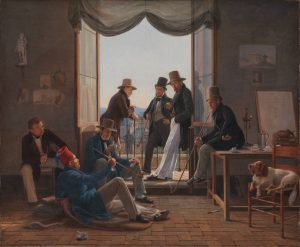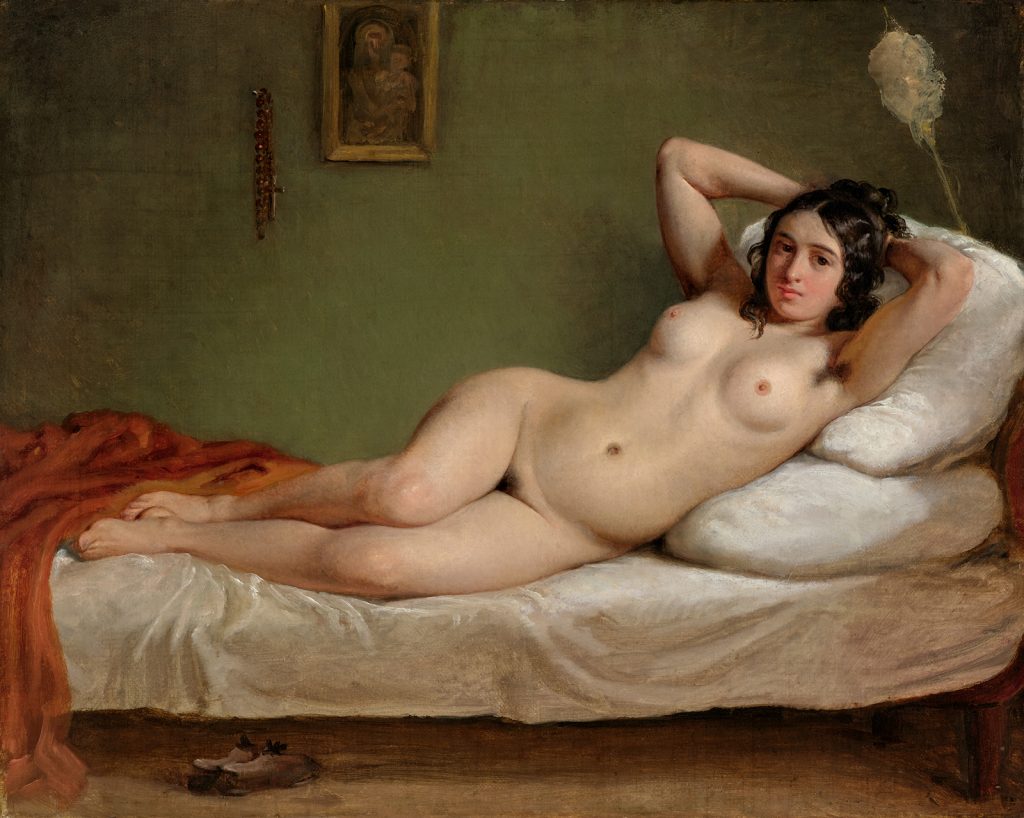Wilhelm Marstrand
(1810 - Copenhagen - 1873)
Maria, Rome 1837
Oil on canvas, 25 x 31 cm
Provenance:
Rasmus Claudius Rasmussen, organist (1820-1904), acquired before 1874;[1]
his sale (first day), Copenhagen, October 17, 1904, lot 77 (repr.);
purchased by foundry owner Knud Gummesen Brandt (1853-1930) and his wife, Petra Hansine Brandt, née Petersen (1852-1922, niece of the painter Christen Købke);
their estate sale, Copenhagen, V. Winkel & Magnussen, auction 77, April 10, 1930, lot 115 (repr.);
purchased by their son, the painter Ernst Vilhelm Brandt (1880-1957);
Gerda Brandt, Copenhagen;
Copenhagen, Bruun Rasmussen, auction 295, May 10, 1973, lot 499 (repr.);
Galerie von Negelein, Kiel;
German private collection
Exhibited:
‘Fyns Stifts Kunstforenings Udstilling’ [exhibition of the arts club in the Diocese of Funen], Odense, May-June 1906, no. 159 (loaned by Knud Gummesen Brandt).
Literature:
Fortegnelse over en Samling Malerier udførte i Olie og Gouache, tilhørende R.C. Rasmussen [catalogue of the Rasmussen collection], Copenhagen 1874, no. 114;
Arne Brenna, ‘Aktmaleri fran dansk Gullalder’, in Konst og Kultur 1974, Jg. 57, p. 89 (repr.);
Konst i Privateye, II, Copenhagen 1985, p. 249, fig. 6.
Wilhelm Marstrand[2] studied at the Royal Danish Academy of Fine Arts in Copenhagen under C. W. Eckersberg from 1826 to 1833. By far the most innovative Danish painter of his generation, Eckersberg was responsible for shaping leading members of the next generation of artists. Initially, Marstrand‘s work was inspired by scenes from everyday life in Copenhagen. After completing his academic training he was awarded a two-year travel bursary and in 1836 set off for Rome, like so many other young Northern painters. He quickly joined the circle of Danish artists working in the city, many of whom he already knew from Eckersberg's studio. Constantin Hansen’s celebrated group portrait (Fig. 1) depicts a gathering of seven Danish artists, including Hansen himself, Marstrand, Martinus Rørbye and Albert Küchler, in a studio in Rome in 1837.

Fig. 1: Constantin Hansen, A Group of Danish Artists in Rome, 1837, oil on canvas, 62 x 74 cm, Statens Museum for Kunst, inv. KMS3236. From left to right: Hansen, Gottlieb Bindesbøll, Martinus Rørbye, Wilhelm Marstrand, Albert Küchler, Ditlev Blunck and Jorgen Sonne.
The colorful street life of Rome gave Marstrand ample opportunity to develop his interest in genre scenes. He visited the environs of Rome to study the traditional dress and customs of the rural population. Today he enjoys a reputation as one of the leading painters of the Danish ‘golden age’. In 2020 a major retrospective of his work titled ‘Wilhelm Marstrand. Den store Foretæller’ [Wilhelm Marstrand. The Great Narrator] was staged at Fuglsang Kunstmuseum, Lolland, later traveling to Nivaagaards Malerisamling in Nivå, Ribe Kunstmuseum and Skovgaard Museet in Viborg.
Until the 1830s, classes involving a living nude female model were still seen by Danish officialdom as violations of academic and social norms. However, a few months after Marstrand had won the Academy’s grand silver medal in March 1833, thereby officially graduating from the Academy, an important innovation in teaching methods took place. In the summer of that year the Academy finally agreed to shelve resistance to the study of female nude models. For the first time, students of the figure drawing class were allowed to work from living female models. Until then, figure drawing classes had only provided male models. Marstrand and other recent academy graduates wasted no time in seizing this unprecedented opportunity. Initially, posing sessions took place in Eckersberg's studio – he was already familiar with the practice from his years of study in Paris.
The young painters will undoubtedly have found it an exciting novelty to study the female nude figure from living models rather than from plaster casts after antique sculptures. This is evident from diary entries which from time to time comment on the beauty of the models. The women were probably from Copenhagen’s lower classes and saw this as a way of earning a little money.

Fig. 2: Constantin Hansen, Female Nude, seen from Behind, June 1833, oil on canvas, 31.7 x 23.6 cm, Copenhagen, Ny Carlsberg Glyptotek

Fig. 3: Christian Købke, Female Nude, seen from Behind, June 1833, oil on canvas, 33 x 25 cm, Copenhagen, Ny Carlsberg Glyptotek
A group of studies made during a posing session with one particular female model in June 1833 have survived. They are the work of different artists studying the same standing model seen from the rear. The studies are unique in the way they document the earliest use of a female model in academic painting in Copenhagen. Artists who participated alongside Eckersberg in the posing session with this model were Marstrand, Hansen (Fig. 2), Købke (Fig. 3), Rørbye and A. Müller – the cream of Denmark’s emerging generation of painters.

Fig. 4: Wilhelm Marstrand, Two Studies of a Reclining Female Model, pencil on paper, 23 x 31 cm, Copenhagen, Statens Museum for Kunst, inv. KKSgb6296
The present painting of a female nude was executed in 1837, a few months after Marstrand’s arrival in Rome. It is thus the direct product of the innovation in teaching methods introduced a few years earlier at the Copenhagen Academy. A characteristic feature of Marstrand’s work is his successful marriage of genre elements with the qualities of a study after nature. A drawing which is now held in the Statens Museum for Kunst in Copenhagen bears the inscription Maria, Campo Vaccino no. 16. It is clearly related to the present painting. It depicts the same model and two variants of her pose. The inscription throws light on the model’s identity and address. A further, more highly finished preparatory study is likely to have existed. In the Copenhagen drawing the interior modeling of the figure is extremely delicate and areas of hatching are finely handled, prerequisites for the remarkable naturalism of the painted version with its skilled rendering of anatomical detail and nuanced treatment of flesh tones. The pose of the young woman, self-confidently holding the spectator’s eye, initially evokes associations with Goya’s masterpiece, La maja desnuda (Fig. 5),[3] executed circa 1800 in Madrid – its identically posed but clothed pendant, La Maja vestida, followed some five years later. It is, however, extremely unlikely that Marstrand knew Goya’s painting. Immediately after their completion the pendants entered the collection of the Spanish Prime Minister Manuel de Godoy and were hung in his private cabinet. In 1808, the two versions were discovered and seized by representatives of the Spanish Inquisition. They were confiscated and kept from public view, languishing in storage until they were finally transferred to the Prado in Madrid in 1901. There is no evidence that a print after La maja desnuda existed in the first half of the nineteenth century, thus ruling out Marstrand’s access to the image.

Fig. 5: Francisco de Goya y Lucientes, La maja desnuda, 1795-1800, oil on canvas, 97.3 x 190.6 cm, Madrid, Museo del Prado.
It is more likely that the pose was inspired by one of the recumbent Venuses of the Renaissance, for example Titian’s Venus of Urbino. But the young woman’s calm self-confidence, at ease with herself in the here and now, her almost slightly gaze and the naturalism of the image – entirely unclassical in its depiction of details such as the presence of body hair – spring from Marstrand’s reading of a direct experience.
The inclusion of simple household items gives the subject a down-to-earth, everyday quality. A painting of the Madonna and Child, a rosary, a pair of slippers carefully placed by the bed, a distaff that the model has tucked behind a pillow offer private insights into a domestic scene. Such might have been the nature of the attractions that awaited a traveler from the North arriving in the bustling environment of early nineteenth-century Rome, with its permissive urban culture.
[1] Rasmus Claudius Rasmussen (1820-1904) was one of the earliest owners of the present painting. Valuable information about his activities and interests as a collector reveals that he earned his living as a music teacher and organist. But he also collected works of art, antiques and coins. He owned a library of some 12,000 volumes and was active in the Copenhagen art scene. The present oil is listed in the catalogue of Rasmussen’s extensive collection, Fortegnelse over en Samling Malerier udførte i Olie og Gouache, tilhørende R.C. Rasmussen which was published in 1874. This indicates that he almost certainly acquired it some time before that date. [2] For a biography of Marstrand, see Wilhelm Marstrand. Den store Fortæller / forfattere, exhib. cat., Fuglsang Kunstmuseum; Nivaagaards Malerisamling; Ribe Kunstmuseum; Skovgaard Museet, 2020. [3] Francisco de Goya y Lucientes, La maja desnuda, 1795-1800, oil on canvas, 97.3 x 190.6 cm, Madrid, Museo del Prado.

